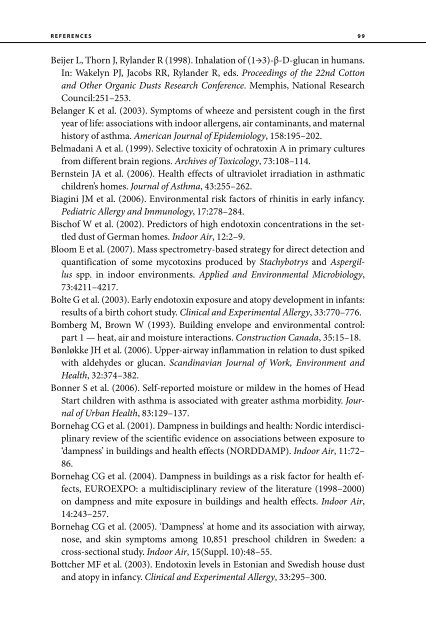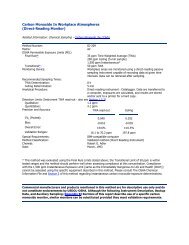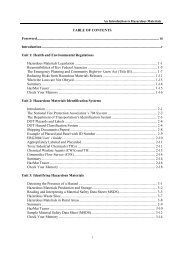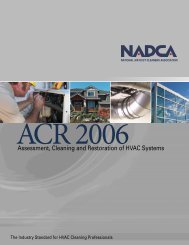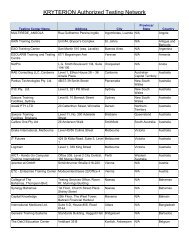Dampness and Mould - WHO guidelines for indoor air quality - PRWeb
Dampness and Mould - WHO guidelines for indoor air quality - PRWeb
Dampness and Mould - WHO guidelines for indoor air quality - PRWeb
Create successful ePaper yourself
Turn your PDF publications into a flip-book with our unique Google optimized e-Paper software.
REFERENCES<br />
99<br />
Beijer L, Thorn J, Ryl<strong>and</strong>er R (1998). Inhalation of (1→3)-β-D-glucan in humans.<br />
In: Wakelyn PJ, Jacobs RR, Ryl<strong>and</strong>er R, eds. Proceedings of the 22nd Cotton<br />
<strong>and</strong> Other Organic Dusts Research Conference. Memphis, National Research<br />
Council:251–253.<br />
Belanger K et al. (2003). Symptoms of wheeze <strong>and</strong> persistent cough in the first<br />
year of life: associations with <strong>indoor</strong> allergens, <strong>air</strong> contaminants, <strong>and</strong> maternal<br />
history of asthma. American Journal of Epidemiology, 158:195–202.<br />
Belmadani A et al. (1999). Selective toxicity of ochratoxin A in primary cultures<br />
from different brain regions. Archives of Toxicology, 73:108–114.<br />
Bernstein JA et al. (2006). Health effects of ultraviolet irradiation in asthmatic<br />
children’s homes. Journal of Asthma, 43:255–262.<br />
Biagini JM et al. (2006). Environmental risk factors of rhinitis in early infancy.<br />
Pediatric Allergy <strong>and</strong> Immunology, 17:278–284.<br />
Bischof W et al. (2002). Predictors of high endotoxin concentrations in the settled<br />
dust of German homes. Indoor Air, 12:2–9.<br />
Bloom E et al. (2007). Mass spectrometry-based strategy <strong>for</strong> direct detection <strong>and</strong><br />
quantification of some mycotoxins produced by Stachybotrys <strong>and</strong> Aspergillus<br />
spp. in <strong>indoor</strong> environments. Applied <strong>and</strong> Environmental Microbiology,<br />
73:4211–4217.<br />
Bolte G et al. (2003). Early endotoxin exposure <strong>and</strong> atopy development in infants:<br />
results of a birth cohort study. Clinical <strong>and</strong> Experimental Allergy, 33:770–776.<br />
Bomberg M, Brown W (1993). Building envelope <strong>and</strong> environmental control:<br />
part 1 — heat, <strong>air</strong> <strong>and</strong> moisture interactions. Construction Canada, 35:15–18.<br />
Bønløkke JH et al. (2006). Upper-<strong>air</strong>way inflammation in relation to dust spiked<br />
with aldehydes or glucan. Sc<strong>and</strong>inavian Journal of Work, Environment <strong>and</strong><br />
Health, 32:374–382.<br />
Bonner S et al. (2006). Self-reported moisture or mildew in the homes of Head<br />
Start children with asthma is associated with greater asthma morbidity. Journal<br />
of Urban Health, 83:129–137.<br />
Bornehag CG et al. (2001). <strong>Dampness</strong> in buildings <strong>and</strong> health: Nordic interdisciplinary<br />
review of the scientific evidence on associations between exposure to<br />
‘dampness’ in buildings <strong>and</strong> health effects (NORDDAMP). Indoor Air, 11:72–<br />
86.<br />
Bornehag CG et al. (2004). <strong>Dampness</strong> in buildings as a risk factor <strong>for</strong> health effects,<br />
EUROEXPO: a multidisciplinary review of the literature (1998–2000)<br />
on dampness <strong>and</strong> mite exposure in buildings <strong>and</strong> health effects. Indoor Air,<br />
14:243–257.<br />
Bornehag CG et al. (2005). ‘<strong>Dampness</strong>’ at home <strong>and</strong> its association with <strong>air</strong>way,<br />
nose, <strong>and</strong> skin symptoms among 10,851 preschool children in Sweden: a<br />
cross-sectional study. Indoor Air, 15(Suppl. 10):48–55.<br />
Bottcher MF et al. (2003). Endotoxin levels in Estonian <strong>and</strong> Swedish house dust<br />
<strong>and</strong> atopy in infancy. Clinical <strong>and</strong> Experimental Allergy, 33:295–300.


